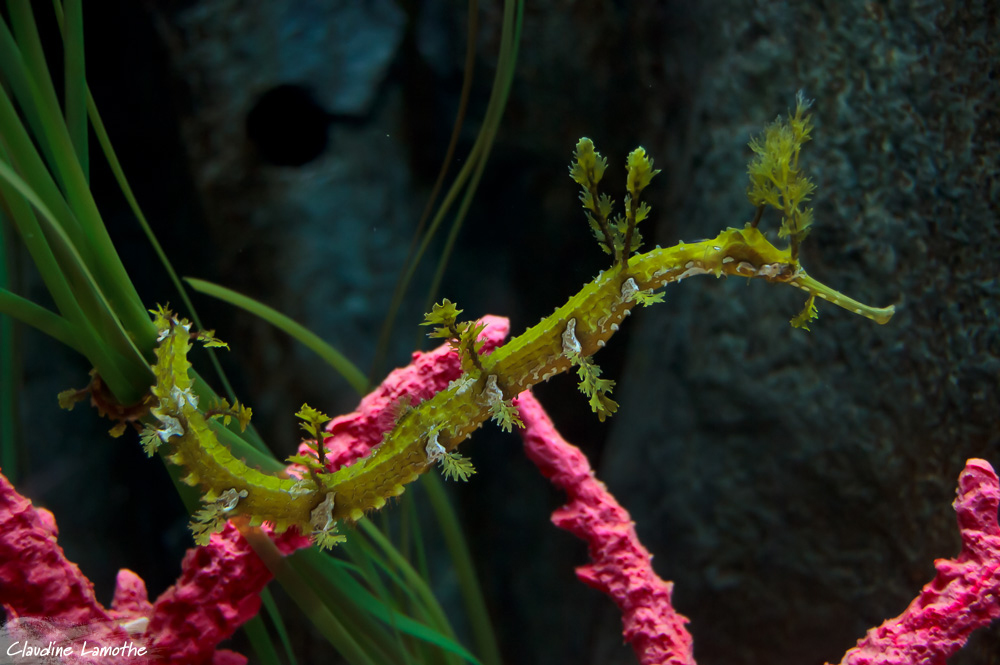- Classification
- ACTINOPTERYGII
- SYNGNATHIFORMES
- SYNGNATHIDAE
- Haliichthys
- taeniophorus
Ribboned Pipehorse, Haliichthys taeniophorus Gray 1859

A Ribboned Pipehorse, Haliichthys taeniophorus, in an aquarium. Source: Claudine Lamothe / Flickr. License: CC by Attribution-NonCommercial
A relatively large green, yellowish or brownish pipefish with prominent branched weed-like appendages on the head and body.
Ribboned Pipehorse, Haliichthys taeniophorus Gray 1859
More Info
|
Distribution |
Shark Bay, Western Australia, to Cape York, Queensland. Elsewhere the species occurs in West Papua, Indonesia, and Papua New Guinea. Inhabits a variety of inshore shallow water areas including weedy regions bordering open substrates, coral reefs, rocky, gravel, sandy and muddy substrates; also associated with sponges, macroalgae, hydroids, shells and seagrasses usually from 1-18 m. |
|
Features |
Dorsal fin 24-27; Pectoral fin 19-22; Trunk rings 18-20; Tail rings 43-47. Superior trunk and tail ridges discontinuous; inferior trunk ridge ending at anal ring; lateral trunk ridge confluent with inferior tail ridge. Head length 5.4-7.1 in TL; snout elongate, length 1.6-1.7 in head length; snout depth 8.6-12.3 in snout length. Head and body spines strong, relatively short, prominent and mostly recurved; spines or knobs on body ridges; dermal flaps and bony knobs present on and above eyes; dermal ‘leafy' appendages on head and body. Caudal fin present in juveniles (short and truncate), absent in sub adults; dorsal fin origin on trunk, fin base elevated. |
|
Size |
To 300 mm TL |
|
Colour |
The colour pattern is variable. Individuals founds in shallow water are mainly greenish-yellow, whereas trawled specimens are often brown to reddish with an irregular blotched pattern, sometimes with indications of narrow dark bars crossing the upper side of body. |
|
Feeding |
Preys on small planktonic crustaceans. |
|
Biology |
The species is ovoviviparous, and males brood embryos in a semi-exposed pouch beneath the tail, with pouch plates and folds present. Males may begin brooding at 16 cm SL. The pear shaped eggs are yellow/orange/amber in colour and are embedded in the epithelial tissue lining of the pouch wall, with the surrounding capillaries supplying oxygen to the developing embryos. |
|
Fisheries |
Inhabits trawling grounds, and may be taken as bycatch by commercial fishers. |
|
Conservation |
Marine listed under the Environment Protection and Biodiversity Conservation Act 1999. |
|
Similar Species |
H. taeniophorus is distinguished from other pipefishes and pipehorses by its large size, elongate snout and leafy appendages on the head and body. |
|
Etymology |
|
|
Species Citation |
Haliichthys taeniophorus Gray 1859, Proc. Zool. Soc. Lond. 1859(27): 39, pl. 7. Type locality: Freycinet's Harbour, Shark Bay, Western Australia. |
|
Author |
Thompson, V.J. & Bray, D.J. 2018 |
|
Resources |
Ribboned Pipehorse, Haliichthys taeniophorus Gray 1859
References
Allen, G.R. 1997. Marine fishes of tropical Australia and south-east Asia. Western Australian Museum, Perth. 292 pp.
Allen, G.R. & Erdmann, M.V. 2012. Reef fishes of the East Indies. Perth : Tropical Reef Research 3 vols, 1260 pp.
Allen, G.R. & Swainston, R. 1988. The Marine Fishes of North-Western Australia. A field guide for anglers and divers. Perth, WA : Western Australian Museum vi 201 pp., 70 pls.
Dawson, C.E. 1985. Indo-Pacific Pipefishes (Red Sea to the Americas). Gulf Coast Research Laboratory, Ocean Springs, Mississippi. 230 pp.
Gloerfelt-Tarp, T. & Kailola, P.J. 1984. Trawled fishes of southern Indonesia and northwestern Australia. Australian Development Assistance Bureau, Australia, Directorate General of Fishes, Indonesia, and German Agency for Technical Cooperation, Federal Republic of Germany. 407 pp.
Gray, J.E. 1859. Decription of a new genus of lophobranchiate fishes from western Australia. Proc. Zool. Soc. Lond. 1859(27): 38-39, pl. 7.
Hutchins, J.B. 2003. Checklist of marine fishes of the Dampier Archipelago, Western Australia. pp. 453-478 in Wells, F.E., Walker, D.I., & Jones, D.S. (eds). Proceedings of the Eleventh International Marine Biological Workshop: The Marine Flora and Fauna of Dampier, Western Australia. Perth : Western Australian Museum.
Kuiter, R.H. 2000. Seahorses, Pipefishes and their Relatives. TMC Publishing, Chorleywood, UK. 240 pp.
Kuiter, R.H. 2009. Seahorses and their relatives. Aquatic Photographics, Seaford, Australia: 1-333.
Larson, H.K., Williams, R.S. & Hammer, M.P. 2013. An annotated checklist of the fishes of the Northern Territory, Australia. Zootaxa 3696(1): 1-293
Larson, H.K. & Williams, R.S. 1997. Darwin Harbour fishes: a survey and annotated checklist. pp. 339-380 in Hanley, H.R., Caswell, G., Megirian, D. & Larson, H.K. (eds). The Marine Flora and Fauna of Darwin Harbour, Northern Territory, Australia. Proceedings of the Sixth International Marine Biology Workshop. Darwin : Museum and Art Gallery of the Northern Territory 466 pp.
Moore, G.I., Morrison, S.M., Hutchins, B.J., Allen, G.R. & Sampey, A. 2014. Kimberley marine biota. Historical data: fishes. Records of the Western Australian Museum, Supplement 84: 161-206
Paulus, T. 1999. Family Syngnathidae. pp 2264-2276, in Capenter K.E. & Niem V.H. (eds) The Living Marine Resources of the Western Central Pacific. FAO Species Identification Guide For Fisheries Purposes. FAO Vol. 4. pp 2069-2790.
Pollom, R. 2016. Haliichthys taeniophorus (errata version published in 2017). The IUCN Red List of Threatened Species 2016: e.T95882787A115515609. http://dx.doi.org/10.2305/IUCN.UK.2016-3.RLTS.T95882787A95882800.en. Downloaded on 24 April 2018.
Pogonoski, J.J., Pollard, D.A. & Paxton, J.R. 2002. Conservation Overview and Action Plan for Australian Threatened and Potentially Threatened Marine and Estuarine Fishes, Environment Australia, Canberra. 375 pp.



